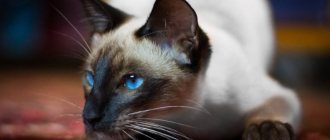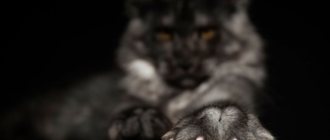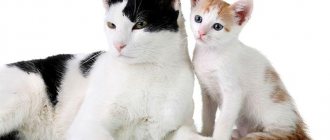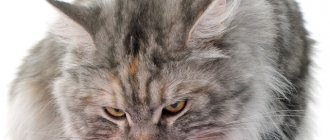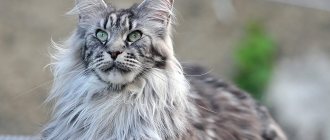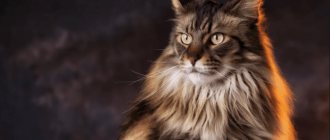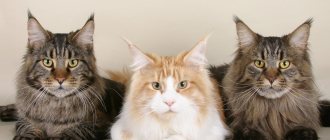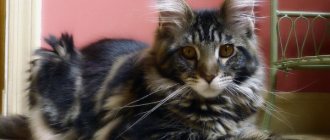The average lifespan of domestic cats is about 15-17 years. The key factors are the living conditions of the animal, the characteristics of the breed, proper care by the owner, and regular visits to the veterinarian.
There are also long-lived cats, living about 20-23 years; their record is often associated with high-quality care and an active lifestyle of the animal itself. How long do Maine Coons live at home?
There is a stereotype that purebred cats are more susceptible to diseases, need mild conditions and do not live long. Actually this is not true.
Representatives of the Maine Coon breed (North American semi-longhair cat) have proven that they are very resilient cats, but require careful care.
With proper care, the lifespan of Maine Coons is more than 12 years; despite their large size, North American semi-longhair cats have good health and are distinguished by their endurance.
According to veterinary clinics and insurance centers, about 50% of North American semi-longhair cats around the world live to the age of 16-17 years.
The rule that the larger the pet, the shorter it lives, applies only to dogs, not cats. The reason lies in the fact that the difference in size between a Maine Coon and an ordinary cat is not as great as between a shepherd dog and a Spitz. Therefore, you should not be afraid to get a large breed cat.
Cats
If you become the owner of a representative of a beautiful breed, then you are probably interested in the question: how long do Maine Coons live as cats at home? We can reassure all owners that with good care and love for their pet, the life of the pet will be long.
On average, Maine Coon cats live about 15-16 years. It is worth noting that females live 1-2 years longer than males. This fact is explained by the characteristics of the breed and natural immunity, which is higher in cats, because they are the ones who have to bear and feed the offspring.
Maine Coons are long-lived
In the United States, a record for life expectancy among Maine Coons was officially registered. The cat Koderoy was born in 1989 and managed to live about twice as long as the representatives of his breed. Success lay in proper nutrition and an active lifestyle, because the cat was by no means a homebody, he spent a lot of time outdoors and hunting. Factors influencing the average lifespan of Maine Coons
To ensure that your North American Longhair cat lives a long life, pay attention to the following factors:
- the pet’s health status (based on the characteristics of the breed, hereditary factors);
- the quality of the conditions in which the cat is kept (the presence of its own space, the absence of dangerous objects and substances in the public domain);
- proper care, including systematic visits to the veterinary clinic and preventive examinations.
How to extend lifespan
Every caring Maine Coon owner wonders what to do to make the cat live as long as possible. To do this, it is necessary to provide the animal with proper care. There are several basic factors that a breeder must take care of.
Nutrition
An inadequate diet and consumption of harmful foods leads to the progression of existing diseases in Maine Coons and the emergence of new ones. Veterinarians recommend choosing the following products for feeding large breed cats:
- lean meat: turkey, beef, chicken, rabbit;
- sea fish;
- fermented milk products: kefir, yogurt, natural yogurt, sour cream;
- quail and chicken eggs - no more than once every 6-7 days;
- fresh, boiled, baked vegetables: broccoli, pumpkin, carrots, cauliflower, zucchini;
- fresh chopped fruits - apples, pears, black currants;
- cereals
You should not overfeed your pet and allow it to become obese. Maine Coons often suffer from hip dysplasia, and excess weight can significantly aggravate the disease.
From industrial feeds, it is recommended to use holistic feeds, as well as premium and super-premium mixtures.
For a complete list of what you can feed your Maine Coon, see the article: “Maine Coon Diet.”
Conditions and care
As practice shows, Maine Coons kept in private homes live longer. The life expectancy of apartment dwellers is somewhat shorter - there the cat is deprived of the opportunity to exercise, breathe fresh air, or “pinch” fresh grass rich in vitamins.
Proper care also affects the lifespan of Maine Coons. The cat should always be kept clean - remove dirt from the nose, wash the eyes and ears, trim the claws. Particular attention must be paid to wool hygiene - you can bathe your pet once every 2-3 weeks, but you need to brush your Maine Coon every day.
It is also necessary to periodically inspect the animal's fur for fleas. To avoid such troubles, it is better to immediately buy a special collar for the cat.
Physical activity
The Maine Coon is a born hunter. Nature inherent in it is the desire to track and catch prey, constant movement. Do not suppress the natural instincts of your pet. After all, a measured, recumbent lifestyle can lead to obesity in a cat.
To maintain physical activity, you need to constantly play with your Maine Coon and walk it at least 2 hours a day. Experienced breeders recommend owners of large cats buy special play complexes for their pets, including houses, scratching posts, multi-level platforms, and vertical posts. Daily exercise will improve your cat's health.
Maine Coons are highly trainable. Therefore, you can choose a simple set of exercises that will not let your pet get bored. Cats of this breed easily follow the commands “sit”, “give paw”, and bring an abandoned toy to the owner.
Sterilization or castration
Castrated and sterilized animals live an order of magnitude longer than pets that have not undergone the corresponding operations. Therefore, if the Maine Coon owner does not plan to breed professionally, veterinarians recommend castration or sterilization. These medical procedures are absolutely harmless to animals.
As a result, the pet will receive inner peace and will not experience seasonal stress. It will also save the energy needed to find a partner. Neutered cats are healthier due to the absence of pregnancies, childbirths, and the absence of nursing kittens.
Spayed and neutered Maine Coons are prone to obesity. Therefore, after the operation, it is recommended to transfer them to specialized industrial feed.
Treatment and prevention
Maine Coons have some health characteristics. This breed of cats is characterized by frequent diseases of the cardiovascular, excretory systems, and musculoskeletal system. Therefore, owners of furry pets need to remember the basic preventive measures aimed at maintaining health:
- The cat should be constantly shown to the veterinarian, at least once every six months. It is also necessary to visit a specialist if your pet behaves strangely: refuses to eat, sleeps a lot, or shows restlessness.
- Starting from 2.5 months, the kitten must be vaccinated against rabies and other diseases (chlamydia, tracheitis, pylencopenia). 7-10 days before vaccination, the animal must be treated for worms, fleas and ticks.
- When feeding a cat natural food, it is recommended, together with a veterinarian, to select the appropriate vitamin and mineral complex (depending on age, gender, nutrition, conditions of detention).
- To maintain healthy teeth and oral cavity, you should introduce solid food into your pet’s diet and buy special sticks for cleaning teeth. Your cat's mouth should be examined by a veterinarian once every six months.
Interesting: “How to choose a Maine Coon kitten.”
How long Maine Coons live is a controversial question. Much depends on the owners. To prolong the life of a pet, you will need to provide it with good care. And the main thing is to show the cat your love and affection. Sometimes this is a decisive factor in increasing the life expectancy of the Maine Coon.
Video: interesting facts about the Maine Coon.
Main causes of premature death
Representatives of the breed are susceptible to the following diseases:
- hypertrophic cardiomyopathy (a hereditary disease that occurs due to gene mutations that affects the contraction of the heart muscles);
- hip dysplasia (can make a young cat disabled and have great difficulty walking);
- back muscle atrophy;
- polycystic kidney disease (presence of cysts from birth that grow and lead to kidney failure).
Death at an early age is possible only from hereditary diseases, so it is extremely important to find a responsible breeder who strictly selects animals for breeding!
What is their character?
Representatives of this breed rarely show it. These are reserved natures who know their worth. They don't turn up their noses, they just behave with dignity. Behind the stern look hides a kind soul. Large creatures have funny habits and are not prone to whims. They have the following features:
- peacefulness and goodwill,
- tact and delicacy,
- independence,
- playfulness and curiosity,
- calmness, quiet voice,
- purring resembles a beautiful melody,
- They never beg for food or steal it from the table, silently waiting for food.
Kittens are ready to frolic without ceasing, and adults do this in the mornings and evenings. During the daytime they prefer to rest. Females behave like true ladies. They show more tenderness and willfulness - either they allow the owner to caress them, or they stop his attempts to stroke or scratch behind the ear.
Disease Prevention
Many diseases that occur in Maine Coons can be avoided if a number of measures are taken in advance:
- a balanced diet, including premium food, fresh meat, vitamins, minerals, and sufficient water;
- compliance with the vaccination schedule for cats, systematic antiparasitic treatment for preventive purposes;
- spacious living space, maintaining an active lifestyle;
- reduction of stressful situations, for Maine Coons this means a change of housing, owner;
- hygienic care of animals;
- systematic observation by a veterinarian.
Coat and color
Maine Coons are long-haired cats.
They have thick, shiny and silky fur. Guard hairs on different parts of the body have different lengths. The short ones cover the area of the head, shoulder blades and limbs, the longer ones grow closer to the tail. The belly, sides, “pants” and “collar” are quite fluffy.
The undercoat is well developed. It is soft to the touch, quite dense and waterproof.
Color – natural, varied. The most common wild colors are black and red marble, black tiger. In Russia, Maine Coons are often white and have various shades of agouti.
Artificial colors (lilac, chocolate, colorpoint, sorel, fawn) are not recognized by most felinological organizations, since they may be the result of interbreeding.
A characteristic feature of cats of this breed is thick and long hair! Short guard hairs grow only on the head and paws of the animal.
If a short-haired or smooth-haired individual is offered under the guise of a Maine Coon, it is likely that it is not a purebred.
To keep the kun healthy
Special complexes help organize a sufficient level of activity for the coon
Problems with teeth and gums can be avoided by regular brushing using a soft brush and special cat paste. And don’t forget to check if the cat has plaque or tartar – if they appear, it is quite possible that the teeth will have to be cleaned with an ultrasound at the veterinarian.
It is very important that your Coon has the opportunity to move and play a lot - cats of this breed are hereditary hunters and cannot be just “sofa cushions”. For the Maine Coon, it is necessary to equip a corner with a platform and various “sports equipment”. Physical activity is the key to your pet’s health and long life.
Tray training
If a kitten is purchased from a breeder, it means that it is already 2-3 months old, and therefore, it knows what a litter box is.
In this case, the baby only needs to be shown a new place where the kitten should go to the toilet. If, for example, a kitten lives in a large house, it is better to have several such litter trays. Some Maine Coons have a characteristic habit of going to one litter box when needed, and to another when needed. If litter box training occurs on your own, you need to pay attention to the animal’s behavior. You can recognize that a kitten needs a toilet by its behavior:
- the animal begins to worry;
- looks for a secluded place;
- squeaks or meows.
If this happens, you most likely need to plant it in a tray. The owner must carefully move his pet. If the kitten does not understand what is required of him, the person should dig a little into the filler with his hand, thereby letting the cat understand what needs to be done here. If you were unable to do this in time and the kitten made a puddle, you need to wipe it off with napkins and put them in the tray. By the smell, the kitten will understand where he needs to go.
Tray training.
average life expectancy
Maine Coons are characterized by good health and, with proper care at home, live no less than other cats. Where do the rumors about their short life expectancy come from and why are sometimes even given certain numbers of 5 - 6, or even 4 years?
Cats in catteries are indeed removed from breeding at approximately this age. But at the same time, they continue to live and delight their owners for many more years. The main reason why breeders do this is their interest in the influx of new blood, which is why the breeding fund in the nursery is updated every few years. But this does not mean that this is due to the fact that the previous producers have become too old: simply, the breeder is no longer interested in getting kittens from them.
Also on breed forums you can often see discussions of pet diseases, including hereditary ones. This can also give the inexperienced owner the impression that Maine Coons are a sickly breed, which is not true.
The statement that Maine Coons live short lives due to their large size also does not stand up to criticism. Proponents of this speculation draw analogies with large and giant breeds of dogs. But this does not apply to cats, and their life expectancy does not depend on growth in any way.
According to studies by European and American experts, cats, on average, live 14 - 16 years, and males - 12 - 15 years.
Details about swimming
Most representatives of the breed treat water with enviable calm, but some individuals can perceive water aggressively. Therefore, raising a Maine Coon and teaching it to bathe must begin at a young age. In any case, the animal should be washed with the doors closed, since this way it will definitely not break free and will not catch a cold due to the draft.
Despite the fact that the breed is considered semi-longhaired, bathing requires compliance with certain rules:
- Before the procedure, the animal must be combed and examined for minor wounds, as well as its claws trimmed and its ears cleaned.
- It is better to bathe not in the bathtub itself, but in a basin or sink, filling the container with warm water to 10 cm.
- To prevent paws from slipping and scratching the coating of the basin, you can lay down a terry towel, but, as experience shows, not every cat is okay with this.
- When washing, it is important to hold your pet firmly by the scruff of the neck. This should be done gently so as not to harm him.
- With your other hand you need to take a large sponge and wet it. Then, use it to rub the shampoo into the animal’s fur. Most likely, after this the pet will calm down.
- The detergent should be applied using a squeezing motion. You should not rub from side to side, as this may tangle the fur.
- If the animal is not infected with parasites, then its head does not need to be touched. If an invasion occurs, then lather it carefully, avoiding foam getting into the eyes, nasal passage and ears.
- After washing, the foam is washed off under a watering can; it is better to help rinse with your hand. The stream should flow with low pressure, and the shower itself should be kept at a distance of at least 2 cm.
- To keep the coat shiny and shiny, use a cat conditioner, which can be removed with water a few minutes after application.
Note! Human shampoos are not suitable for cats. For these cases, special zoo shampoos and other products should be used. Remember, bathing is stressful for your pet. He will endure the procedure much easier if you talk to him kindly and encourage him in every possible way.
Upon completion of the procedure, you should dip your pet’s fur with a paper or terry towel, after which you can begin drying. If your four-legged friend is not afraid of a hair dryer, then this method will be optimal because it is fast. Otherwise, you can leave the wool to dry naturally, but you should avoid drafts.
After drying, the animal is combed according to the following scheme:
- from bottom to top - on the chest, throat, ears and cheeks;
- up - on the sides;
- from the center in different directions - on the stomach;
- paws fluff up.
It is better not to carry out the procedure too often, as this may disrupt the oiliness of the skin. It is advisable - less than once a month, but before exhibitions and after contamination, you can wash your pet more often.
Each cat is different, and to be as comfortable as possible, it requires an individualized approach, which can most easily be derived from breed guidelines. Source: Flickr (Carl_Spencer)
How to structure training sessions
The main principle is consistency. Prohibitions and restrictions for kittens should be repeated regularly in a calm and friendly tone. You cannot voice them as orders. A loud or rude voice will also not produce the desired results.
Exercise should take no more than 15 minutes a day. It will be easier and easier if the animal receives a reward upon completion. It is worth stopping the session if the kitten gets angry or you get angry. A positive attitude during training and after it will speed up the learning process.
Care for claws and teeth
If your cat receives dry food, you can brush your teeth once a month. When receiving soft food, you need to clean it more often - 2-3 times a month. The brush is selected depending on the size of the animal. The animal takes care of its claws on its own, the main thing is that it has a special scratching post. Otherwise, the upholstered furniture or wood in the house will suffer.
Description of the breed
Maine Coons have very distinctive fur.
It is usually long, shaggy and very smooth along the body. The fur is longest at the front and on the tail, which is soft and fluffy, with rings of darker coloring around it.
Eyes can vary in color, including green, blue, gold or copper.
The eyes are more rounded than other cat breeds and very large.
The faces are small, with high cheekbones, while the cats have wide chests and their bodies are long.
Adapted by nature to withstand harsh weather conditions, they also have well-padded furry paws.
- Black
- Blue
- Cream
- White
- Black and white
- Blue and white
- Cream and white
- Red and white
Maine Coon Tabby
The Maine Coon Tabby has the traditional tabby cat fur. With spots and spots of different colors all over the fur.
Although the most common Maine Coon Tabby has shades of brown, this pattern can be made up in a variety of other colors.
Typical Maine Coon shades include:
- Black silver Tibetan tabby
- Black silver Thorby
- Brown Tibetan Tabby
- Brown Tibetan tabby with white
- Brown Tibet Torby
- Red tabby
- Red Tibetan tabby with white
Another color variety you can find is the shade Maine Coon.
These beautiful cats are often described as "smoky" because their coat patterns and color tones are muted and mixed.
One of the most popular is the Blue Smoke Maine Coon.
Shaded Maine Coon cats include:
- Black smoke
- Blue smoke
- Cream smoke
- Red smoke
- Shaded Silver
- Shaded Blue Silver
- Smoky Thorby
- Blue cream smoke
There are a large number of cat species in the world, but the Maine Coon is considered the largest cat in the cat family. They reach a weight of 10 kilograms. The kitty is lighter and smaller than a cat, but has a more aggressive face.
It is a misconception that huge cats eat a lot; in this they are no different from the most common and medium-sized cats.
These are amazing cats, with perfect memory and intelligence. With excellent coat and an easy-going, soft character, despite its impressive proportions.
For what reasons does a cat baby not gain weight?
Maine Coons usually grow well and quickly, and by the age of 2 months their weight can reach 1.5 kg. But it also happens that the Maine Coon does not gain weight, which is not the norm. Reasons thought to contribute to poor weight and height gain include:
- Poor food for mother cat.
Lactating female Maine Coons are fed at least 3 times a day with special food for lactating cats or food prepared by a caring owner (lean meat, fresh dairy products, cereals, occasionally fish and boiled eggs, vegetables and vitamins prescribed by a specialist); - If the cat is still too small, he may simply weakly suck his mother's milk.
Or the cat’s milk itself is not enough. To keep babies fed, some owners feed them with cat milk substitutes; - Harmful (toxic) mother's milk.
Milk can be dangerous if the animal suffers from mastitis, metritis, or uterine abscess - problems that are common after childbirth. The milk of an animal that is treated with any medications without the consent of a veterinarian is not at all beneficial; - Lack of vitamins and anemia.
If there are few useful components in mother's milk, Maine Coon babies can easily grow poorly and slowly, and be weak; - Worms.
These parasites are often transmitted to kittens from the mother through milk. Naturally, worms do not leave a chance for weight gain; - Genetic deviation.
It happens that among five kittens one weighs very little and looks too weak. This happens with people too, when one of the twins is in full health, and the other is on the verge; - Disease.
In fact, any disease that was transmitted to the baby from a cat or developed independently can affect weight gain. When the kitten is clearly not feeling well (stool problems, vomiting, temperature (normally it should be 38.5-39.5 degrees), discharge from the nose and eyes, plaintive meowing, etc.), you should quickly run to the veterinarian or call a doctor on house; - Crossing a Maine Coon female with an outbred male.
Usually such cases are excluded, but sometimes they still occur. A half-breed cat may well gain weight more slowly than its purebred counterpart.
The Internet is full of advice on what drug can be administered to a small Maine Coon. Trusting recommendations from cat forums is not always wise. Many medications can do more harm than good. In addition, without a correct diagnosis, treatment cannot begin.
Sterilization of cats
Sterilizing a cat is more difficult. This is an abdominal operation, also performed under general anesthesia. There are two methods of sterilization - tubal ligation and removal of the ovaries, uterus and fallopian tubes. The first method only prevents the cat from becoming pregnant, leaving all hormonal and psychological problems unresolved, so it is recommended to perform the operation using the second method.
After surgery, the cat needs postoperative care for several days - treatment of sutures. To prevent infection from getting into the fresh stitches, the cat is put on a special blanket with ties on the back, covering the pet’s stomach and chest. After approximately 10 days, the sutures are removed and the animal returns to its normal life.
During the first time after surgery, it is advisable to keep the Maine Coon constantly in sight and not allow the animal to jump or run until the wounds and stitches heal.

